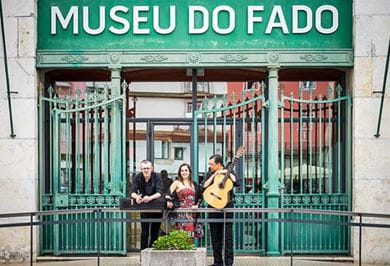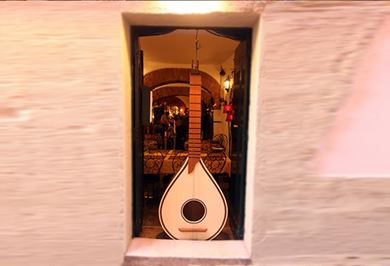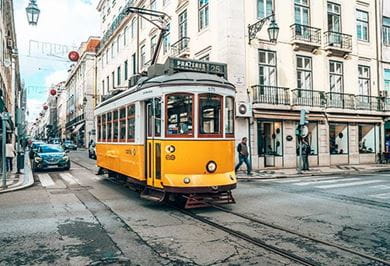






Portugal’s capital city of blues from the ubiquitous blue tiling adorning buildings to fado, the soulful music and song performed in the warm evenings in rather secluded and secretive fado houses are the soul of the thriving city
he mournful songs known as fado are the blues of Portugal’s capital Lisbon. Fado means ‘fate’ and saudade; a kind of hopeless melancholy fills the lyrics - rarely written down - and themes. Love, usually hopeless, is woven with the sadness of the lonely life at sea and parting. In 2011, fado was awarded UNESCOs ‘intangible heritage of humanity’ status.
The songs sung without microphones and to a silent audience are essentially emotional and the voices to be good need to be ‘wine voices’; deep, throaty, throbbing; a wail of pain reflecting the sadness of life. The beauty of the performer is in the voice not the face. Livelier are the fado songs in praise of Lisbon often sung during the June city festivals and parades. June in Alfama is the most romantic time to hear fado when performers backed by guitarists sing on the steep steps that stitch the hilly streets together.
The origins of fado are obscure; perhaps Moorish since classical fado has a slow, more African, throb or it derived from lovesick and homesick sailors at sea. Either way, it is best heard in the originally Moorish areas of Lisbon: Alfama and neighbouring Mouraria separated by the steep hill that supports Lisbon’s iconic building the Castelo Sao Jorge.
Though fado houses can now be found in many parts of the city, Mouraria was where fado was born. It was home to the singer Severa; the original 18th century fadista and the mistress of the Marques de Marialua who gave Lisbon the term ‘Marialuism’ to describe a swaggering macho pride. Severa lived in a little house on Rua do Capelao in Mouraria where visitors inside and in the street outside stand and listen to the songs she sang. The walls of Rua do Capelao are a permanent gallery of leading fado singers whose photos have been literally printed on the wall. Fado fascinates and is a flexible music genre; it is the magic of the so called ‘wine voice’ issuing from a woman who is not a stereotyped modern beauty who holds hushed attention by her voice, the accompaniment of two Portuguese guitars, 12 stringed and lute shaped, the guitarists not always aware of what the next song will be until the singer starts, the neat business-suited middle-aged man who produces passionate notes that overcome language barriers.
Good places to get one’s ear in are Clube do Fado in Alfama owned by Mario Pacheca, a Portuguese guitar player who played with the famed Amalia Rodrigues who brought fado to international attention. O Faia in Bairro Alto, owned by a singer, has an intimate feel in the stone arched room where singers like Lenita Gentil and Antonio Rocha perform. In Mouraria many of the small restaurants and bars like Bar Anos 60 offer fado.
To learn the history, lyrics and instruments of fado, the modern Fado Museum on Largo do Chafariz de Dentro by the river Tagus guides the visitor gently at his or her own pace with excellent audio guides and plenty of interactive opportunities to sit and listen to favourite fado singers and players. All that throaty singing arouses a thirst and a pleasant place for a drink or meal is A Travessa do Fado at the museum for tapas style sharing dishes; garlic prawns, asparagus in light bater, stews, and black pork with baby beans go well with a glass of vinho verde. Late afternoon one may be serenaded by guitarists.Mouraria is one of the oldest Lisbon districts, which became a Moorish settlement after their defeat in the siege of Lisbon in 1147 during the second crusade. Gradually immigrants from former Portuguese colonies followed them into this labyrinth of snaking, umbrella wide alleys and mini-squares slithering downhill from the horizon guarding Castelo de Sao Jorge. In 2008 the Renovate Mouraria (renovaramouraria.pt) organisation was created to revitalise and clean up the neighbourhood. It provides free information, guided themed tours - especially fado - and courses from yoga to tapestry and Portuguese language. The high balconied houses, coated with typical Portuguese azuelos tiling, are being restored as shops, apartments, galleries and ateliers given a vibrance by the multi-cultured inhabitants from India, China, Africa and Brazil. It can be reached by a canary yellow, old fashioned tram 28 that bears visitors from the central Rua Dom Duarte up to Castelo de Sao Jorge dating back to the fifth century that was a royal residence for a thousand years, was destroyed in Lisbon’s great earthquake of 1755 and now is the place to oversee the city from its ramparts and gardens of lime trees and cypress among which peacocks strut.
Below the castle, new look Mouraria starts at the large open space named Martim Moniz; a sunny sweep of tables, parasols, the setting of cultural events and street markets. Stalls showing Mouraria’s diverse ethnic makeup edge the square offering everything from curries to Brazilian grills. The cultural mix comes together in the bustle of the multi-storey Centro Commercial where tiny shops are crammed with goods like the Indian Popat where Lisbon’s foodies buy their spices.
Mouraria offers an increasing number of small but characterful cafes, bars, tasquinhas - small inexpensive bistro like eateries - and restaurants. Tavern crawls are organised to experience different cultures; visitors can listen to morna from Cape Verde while drinking a ginjinha cherry brandy, take in some fado with a Goan sarapatel, a samba with Brazilian prawn muqueca. O Fornodo Alfarrabister specialises in bean soup and Saturday evening fado, Tentoaçes de Goa in Goan food, Restaurante Paquistanes in tandoori chicken. And in the slim streets on warm spring evenings one can often hear the plaintive wail of fado.
Musical genre
Maria Severa Onofriana, also known simply as A Severa, was a Portuguese fado singer and guitarist. She is regarded as the first fado singer to have risen to fame in her short life, attaining a near-mythical status after her death. The singer of fado (literally, “fate”) speaks to the often harsh realities of everyday life, sometimes with a sense of resignation, sometimes with the hope of resolution.
Nita Mukesh Ambani Cultural Centre brings to the city a vibrant space for the world of music, dance, ...
I sometimes feel as though the legacy of Lord Kitchener has pursued me all of my life. I studied his ...
In 1992, Prince Charles, the Prince of Wales and heir to the British Throne visited India along with ...
Should one risk a vacation in the middle of pandemic? I thought long and hard about it before decidi ...
The Mona Lisa traces back herself to her artist Leonardo da Vinci’s life at Château du Clos Lucé in ...
The Oberoi Beach Resort, Lombok has undergone rejuvenation and evolved into a destination of unrival ...
A vivid tour through the hottest Bree Street’s central reaches that we call home to the ethical food ...
The Oberoi Beach Resort, Sahl Hasheesh, offers a royal experience amidst the colourful sea life at E ...
Located at the junction of Aravali and Vindhya ranges, Ranthambhore National Park was once a private ...
William Shakespeare lived through one of the most turbulent yet thrilling era’s of English history ...
While central Melbourne has its own allure, the city’s charm lies in its diverse suburbs, each of wh ...
Adrian Rohnfelder, a photographer with a keen interest in volcanoes and adventure, shares his extrao ...
Witness the journey of a wooden instrument that broke all the records to become the backbone of Arab ...
To leap beyond imposed restrictive limits of existence is precisely what Dimpy Menon’s artworks spea ...
More than just a circus, Phare performers use theater, music, dance and modern circus arts to tell u ...
Peru is one of the peak experiences in travel. Nowhere on earth is there such an incredibly wide ran ...
The Oberoi Sukhvilas Spa Resort, New Chandigarh helps you get in touch with yourself so that you liv ...
The establishment of the British Empire greatly influenced the architecture and culture of India an ...
Complete with red sandstone fort, torch lit ramparts and ‘Haveli’ mansions, The Oberoi Rajvilās, Jai ...
Come aboard The Oberoi Zahra, Luxury Nile Cruiser for a delightful mix of luxury and history ...
The incredible Turtle Sanctuary at The Oberoi Beach Resort, Bali, is a must-visit for nature lovers ...
As part of the Beatles, arguably the most iconic rock band of all time, John Lennon and Paul McCartn ...
Oberoi Hotels & Resorts have won the hearts of many with its exquisite charm and glorious stays ...
When I work with a subject, whether it is landscape or nudes, I’m in a relationship with whatever’s ...
My conceptual concerts initiate dialogue using various art forms. I wanted to produce works that are ...
From sticky toffee pudding and gastro pubs, to farmers markets, heritage farm meat and stalls housin ...
German art historian Sebastian Schütze, a creative master and precise in technique, captures the hum ...
The Italian art witnessed drastic movements in the period between 1850 to 1950, giving a platform fo ...
All associated with Mughal emperors, maharajas and their courts, the Al Thani Collection is a marvel ...
In the age of art as speculative and subjective, beauty can seem very much beside the point. But sta ...
Complex narratives are the peak of excitement for me. Narratives like double portraits provide stimu ...
At the helm of his eponymous brand, Fendi and Chanel, the late Karl Lagerfeld became as iconic as th ...
Essentially an attempt to replicate a beautiful representation on the canvas, I hope to convey the c ...
The Oberoi, New Delhi’s makeover is an inspiration of the contemporary interpretation of Sir Edward ...
An institution rather than a hotel, the glorious Oberoi Grand, Kolkata is the place tradition calls ...
Ginarte is a journey into beauty, a harmonic synthesis, an expression of strength and delicacy, a hy ...
Oberoi Hotels & Resorts has been ranked the world’s Best Hotel Group at the Telegraph Travel Awards ...
With more than 400 displays, Toward a Concrete Utopia: Architecture in Yugoslavia, 1948–1980, is the ...
Life of the royals in medieval England, especially the queens, was full of intrigue and scandal but ...
The Asian art scene, though young, is booming and art fairs continue to play a significant role in t ...
From ebonised Georgian bracket to 19th-century French brass carriage and the 21st-century Jaeger Le- ...
The East India Company was one of the most powerful commercial endeavours the world has ever seen, d ...
With more than 400 displays, Toward a Concrete Utopia: Architecture in Yugoslavia, 1948–1980, is the ...
The Oberoi Rajvilas, Jaipur offers an exemplary experience of luxury that transports you to the gold ...
Winner of “Middle East’s Leading Luxury City Hotel” for five consecutive years by the coveted World ...
With elegantly designed villas that offer the best of interiors to its patrons, The Oberoi Beach Res ...
On the north-west coast of Africa lies Casablanca, an ancient exotic land embraced in the sweeping s ...
The new uniforms adorning the staff at The Oberoi, New Delhi are a reflection of The Oberoi Group’s ...
Swan Lake, the iconic ballet composed by Pyotr Ilyich Tchaikovsky in the late 19th century, continue ...
The Buddha, in his many iterations across South Asia, is most exquisitely represented in gilt-bronze ...
At luxury watch brand Carl F Bucherer, design is about bringing together form and function to create ...
Queen, temptress, politician, murderer: Cleopatra remains an object of fascination for writers, arti ...
Go pedal-to-metal with the best track-ready cars unveiled at the 2018 Geneva Motor Show ...
With an enchanting combination of natural splendour, medieval heritage and modern luxury, The Oberoi ...
The Oberoi Udaivilas, Udaipur, brings together the finest in nature, luxury and impeccable service t ...
The Oberoi Amarvilas, Agra, has been voted the Top India Resort Hotel at the Travel + Leisure, USA W ...
Swiss Photographer Christian Tagliavini captures 15th and 16th-century courtly culture in a series o ...
As innovations in air travel bring the UK and Australia closer, the Kangaroo Route – once stretched ...
The Oberoi, Gurgaon offers a traveller more than just the opulence of a five-star hotel: it is a san ...
In the year 1936, legendary artist Henri Matisse executed with the utmost elegance a charcoal portra ...
The elegant suites at The Oberoi, Mumbai, provide an unrivalled experience of The Oberoi Group’s sig ...
The art collection of David and Peggy Rockefeller has garnered the highest total for any private col ...
The Oberoi Philae, Luxury Nile Cruiser takes you through the highlights of the Egyptian river on a s ...
Complementing its signature old-world charm with the finest of contemporary facilities, this Oberoi ...
Truly great experiences in life, are integral to a design sensibility that seeks to create a visual ...
Modern Indian cuisine is coming into its own, with pioneering Indian chefs like Vineet Bhatia, Gagga ...
Sailing along the River Nile aboard The Oberoi Zahra, Nile Cruiser, explore Egypt’s mystical tombs a ...
Late entertainer David Bowie’s art collection, recently auctioned by Sotheby’s, is an eclectic mix o ...
Majestic lions, magnificent wild elephants and an untouched, untainted landscape weaving together na ...
From Jean Paul Gaultier and Christian Dior to Emilio Pucci and Christian Louboutin, international fa ...
world are among the most highly coveted collectible antiques today ...
Home to the perfect confluence of nature and concrete, Al Zorah gives to luxury travellers the getaw ...
An institution rather than a hotel, the glorious Oberoi Grand, Kolkata is the place tradition calls ...
Combine the exhilaration of a jungle adventure with the relaxation of a luxurious retreat at this sp ...
From exotic varieties to beautiful native species, trees can transform your estate into your own sli ...
The East and the West might speak distinct design languages, but bring them together and a spectacul ...
In the land of the midnight sun, a quintessential family vacation is punctuated by a breathtaking ex ...
The misty Wuyi mountains in Fujian, China are home to Da Hong Pao tea, which can sell for more than ...
Award-winning architect Francis Kéré talks about his design journey and giving back to his homeland ...
In Milan, designer Arthur Arbesser and his associates work and play together, perhaps setting a temp ...
Magnates of the luxury world have been taking charitable steps into the world of European applied ar ...
The culinary offerings at The Oberoi Beach Resort, Al Zorah, reflect its vibe of simple sophisticati ...
The works of 18th-century chaser-gilder Pierre Gouthiere stand testimony to the aesthetic opulence o ...
The inner health of an organisation is as important as the external forces that influence its ascent ...
The artistic traditions of mounted porcelain and enamelling lend a whimsical air to some of the most ...
The finest works of literature can sometimes make for the finest works of cinema, and the list of fi ...
The iconic Victorian writer and social critic, seen through the eyes of his great-great-great grandd ...
Be a part of the legacy of turtle conservation on the island of Bali at this luxurious beachside hav ...
With impeccable culinary offerings, Mauritian archaeological heritage and the best location on the i ...
As The Oberoi, New Delhi revels in its newly reopened avatar, take a trip down memory lane and follo ...
Passion, craftsmanship and innovation are the defining aspects of Automobili Lamborghini’s design ae ...
As the universe of food undergoes a rapid transformation across the world, The Oberoi, New Delhi’s a ...
Fashion photography is about more than garments and labels - it is about penetrating the physical fo ...
With an artistic masterpiece by Sir Winston Churchill, The Goldfish Pool at Chartwell, recently goin ...
Balancing modernity with its centuries-old heritage, Amsterdam is a study in splendour and historica ...
Dance does not exist in a box and no rules must necessarily govern it. It is a thing of beauty, myst ...
Nestled within an impregnable valley, the “lost city” of Petra is a spectacular expression of cultur ...
Oberoi Hotels & Resorts has been ranked the world’s Best Hotel Group at the Telegraph Travel Awards ...
Ayurveda, natural healing and mindfulness together create a space of rejuvenation like no other at ...
Beginning in the national capital, make your way through these travel hotspots across India that ref ...
Leonardo da Vinci’s Salvator Mundi claimed a place in auction history recently, setting a new record ...
As the beacon of Western classical music continues to shine bright, a younger generation of musician ...
One fine April morning, 16 actors and technicians set out to take Shakespeare’s Hamlet around the wo ...
From gold snuff boxes inset with diamonds, amethysts and sapphires to ornately enamelled perfume fla ...
The written word, in conjunction with innovations, lies at the very heart of history, shaping cultu ...
August 1947: It had been more than a week since freedom had arrived and the country partitioned. But ...
The Biennale des Antiquaires culminated this year in stunning glory, only to cast its spell afresh n ...
Over the years, I must have observed and recorded the behaviour of at least 125 tigers in Ranthambho ...
The ancient science of Ayurveda tells you how best to enhance your beauty and nourish not only your ...
The gleaming, fluorescent-green topsides of the superyacht Inouï may scream luxury at the Maxi Yacht ...
The world is changing and it is not changing to the benefit of the manufacturers and retailers of so ...
This season, drive in style with these uber-luxurious four-wheeled debutantes ...
The phrase, ‘home is where the heart is’ acquired a new meaning for the children at SOS Children’s V ...
India’s finest private collections of classical Indian art mindfully preserve its creative heritage ...
Make memories last forever by taking your most cherished photographs beyond the frame and photo albu ...
With breathtaking views, luxurious rooms, rejuvenating spa therapies and a state-of-the-art golf cou ...
Seamlessly weaving together traditional elements of Indian architecture, aesthetically landscaped ga ...
Exquisite collectibles going under the hammer are letting connoisseurs acquire a little bit of histo ...
Coming to India in 1865 as the principal of an art school, John Lockwood Kipling made an invaluable ...
When travelling along the path of kings and queens, The Oberoi Hotels & Resorts offer a palatial pla ...
For luxury travellers, the sky is the limit, quite literally, as a gourmet open-air meal at the base ...
From 18th-century ormolu clocks framed by candelabra to enamelled 19th-century timepieces, mantel cl ...
The Emirate of Ajman is home to The Oberoi Beach Resort, Al Zorah, a modern architectural masterpiec ...
The last queen of France was a great commissioner of beautiful things, and several of the shops she ...
From exclusive garments manufactured in Italy to style inspirations drawn from art, this is what the ...
A new facet of Pablo Picasso’s artistic repertoire is taking over the international art market his c ...
Every bottle of vintage wine has a story to tell. We give you the narratives behind five of the fine ...
In the universe of Modern art, rivalry is a complex dynamic that enables one artist to be influenced ...
A story is conditional – it is a matter of perception and might not always be, subliminally or even ...
From unique water and land activities to certified diving courses, desert tours and more, this all-s ...
Enrich your stay in Ranthambhore at this opulent jungle resort, in close proximity to nature, yet ne ...
With performative nuances and provocative appeal, Western classical music has evolved into a complex ...







Second child until maximum age of 12 years will be accommodated in the same room at additional supplement. The additional amount is not included in the room price mentioned and shall be payable at the hotel during check-out.
400 AED (including tax)
250 AED (including tax)





